Centos7+Open***使用用户及密码验证登陆
Centos7+Open***使用用户及密码验证登陆
我们上一篇文章介绍了Centos7+Open***使用证书验证登陆介绍,今天我们介绍Centos7+Open***使用用户及密码登陆验证,具体就补多少了,环境还是基于上一篇的更改来完成。
我们使用Centos7+Open***使用用户及密码登陆验证小下载一个验证脚本来完成用户验证登陆。
http://open***.se/files/other/checkpsw.sh
#!/bin/sh
###########################################################
# checkpsw.sh (C) 2004 Mathias Sundman <mathias@open***.se>
#
# This script will authenticate Open××× users against
# a plain text file. The passfile should simply contain
# one row per user with the username first followed by
# one or more space(s) or tab(s) and then the password.
PASSFILE="/usr/local/open***/etc/psw-file"
LOG_FILE="/usr/local/open***/var/open***-password.log"
TIME_STAMP=`date "+%Y-%m-%d %T"`
###########################################################
if [ ! -r "${PASSFILE}" ]; thenecho "${TIME_STAMP}: Could not open password file \"${PASSFILE}\" for reading." >>
${LOG_FILE}exit 1
fi
CORRECT_PASSWORD=`awk '!/^;/&&!/^#/&&$1=="'${username}'"{print $2;exit}' ${PASSFILE}`
if [ "${CORRECT_PASSWORD}" = "" ]; then echo "${TIME_STAMP}: User does not exist: username=\"${username}\", password=
\"${password}\"." >> ${LOG_FILE}exit 1
fi
if [ "${password}" = "${CORRECT_PASSWORD}" ]; then echo "${TIME_STAMP}: Successful authentication: username=\"${username}\"." >> ${LOG_FILE}exit 0
fi
echo "${TIME_STAMP}: Incorrect password: username=\"${username}\", password=
\"${password}\"." >> ${LOG_FILE}
exit 1
我们然后进入open***的配置目录
cd /etc/open***/ vi checkpsw.sh
然后将脚本文件粘贴,然后需要修改PASSFILE和LOG_FILE的路劲,根据自己的真是路劲修改
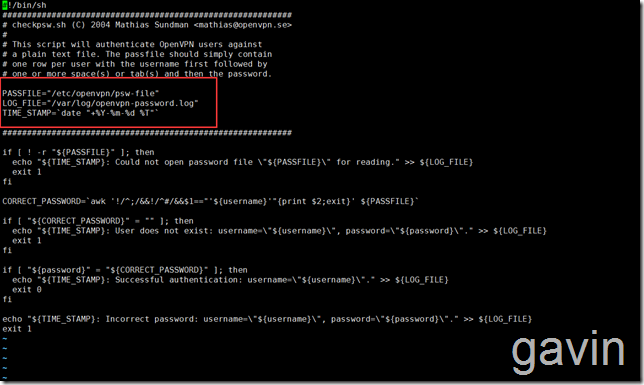
保存退出,然后我们需要修改open***的server.conf 文件,然后添加以下配置字段
auth-user-pass-verify /etc/open***/userauthdir/checkpsw.sh via-env 开启用户密码脚本: client-cert-not-required 取消客户端的证书认证: username-as-common-name 不要求客户端有证书 script-security 3 system 消除以下警告
我们在修改前先看看上一篇的配置文件内容
我们为了更好的体现配置,将原来的server.conf文件进行过滤注释的内容,然后拷贝出来新建一个server.conf文件,然后将没有注释的内容添加到新建的server.conf文件中这样为了更好的配置和拍错。
我们上一节是在默认的server.conf文件里面直接修改的,所以我们需要将没有注释的内容过滤出来,我们先看看默认的配置文件内容
[root@open*** open***]# cat server.conf ################################################# # Sample Open××× 2.0 config file for # # multi-client server. # # # # This file is for the server side # # of a many-clients <-> one-server # # Open××× configuration. # # # # Open××× also supports # # single-machine <-> single-machine # # configurations (See the Examples page # # on the web site for more info). # # # # This config should work on Windows # # or Linux/BSD systems. Remember on # # Windows to quote pathnames and use # # double backslashes, e.g.: # # "C:\\Program Files\\Open×××\\config\\foo.key" # # # # Comments are preceded with '#' or ';' # ################################################# # Which local IP address should Open××× # listen on? (optional) ;local a.b.c.d # Which TCP/UDP port should Open××× listen on? # If you want to run multiple Open××× instances # on the same machine, use a different port # number for each one. You will need to # open up this port on your firewall. port 1194 # TCP or UDP server? proto tcp #proto udp # "dev tun" will create a routed IP tunnel, # "dev tap" will create an ethernet tunnel. # Use "dev tap0" if you are ethernet bridging # and have precreated a tap0 virtual interface # and bridged it with your ethernet interface. # If you want to control access policies # over the ×××, you must create firewall # rules for the the TUN/TAP interface. # On non-Windows systems, you can give # an explicit unit number, such as tun0. # On Windows, use "dev-node" for this. # On most systems, the ××× will not function # unless you partially or fully disable # the firewall for the TUN/TAP interface. ;dev tap dev tun # Windows needs the TAP-Win32 adapter name # from the Network Connections panel if you # have more than one. On XP SP2 or higher, # you may need to selectively disable the # Windows firewall for the TAP adapter. # Non-Windows systems usually don't need this. ;dev-node MyTap # SSL/TLS root certificate (ca), certificate # (cert), and private key (key). Each client # and the server must have their own cert and # key file. The server and all clients will # use the same ca file. # # See the "easy-rsa" directory for a series # of scripts for generating RSA certificates # and private keys. Remember to use # a unique Common Name for the server # and each of the client certificates. # # Any X509 key management system can be used. # Open××× can also use a PKCS #12 formatted key file # (see "pkcs12" directive in man page). ca ca.crt cert server.crt key server.key # This file should be kept secret # Diffie hellman parameters. # Generate your own with: # openssl dhparam -out dh2048.pem 2048 dh dh2048.pem # Network topology # Should be subnet (addressing via IP) # unless Windows clients v2.0.9 and lower have to # be supported (then net30, i.e. a /30 per client) # Defaults to net30 (not recommended) ;topology subnet # Configure server mode and supply a ××× subnet # for Open××× to draw client addresses from. # The server will take 10.8.0.1 for itself, # the rest will be made available to clients. # Each client will be able to reach the server # on 10.8.0.1. Comment this line out if you are # ethernet bridging. See the man page for more info. server 10.10.10.0 255.255.255.0 # Maintain a record of client <-> virtual IP address # associations in this file. If Open××× goes down or # is restarted, reconnecting clients can be assigned # the same virtual IP address from the pool that was # previously assigned. ifconfig-pool-persist ipp.txt # Configure server mode for ethernet bridging. # You must first use your OS's bridging capability # to bridge the TAP interface with the ethernet # NIC interface. Then you must manually set the # IP/netmask on the bridge interface, here we # assume 10.8.0.4/255.255.255.0. Finally we # must set aside an IP range in this subnet # (start=10.8.0.50 end=10.8.0.100) to allocate # to connecting clients. Leave this line commented # out unless you are ethernet bridging. ;server-bridge 10.8.0.4 255.255.255.0 10.8.0.50 10.8.0.100 # Configure server mode for ethernet bridging # using a DHCP-proxy, where clients talk # to the Open××× server-side DHCP server # to receive their IP address allocation # and DNS server addresses. You must first use # your OS's bridging capability to bridge the TAP # interface with the ethernet NIC interface. # Note: this mode only works on clients (such as # Windows), where the client-side TAP adapter is # bound to a DHCP client. ;server-bridge # Push routes to the client to allow it # to reach other private subnets behind # the server. Remember that these # private subnets will also need # to know to route the Open××× client # address pool (10.8.0.0/255.255.255.0) # back to the Open××× server. push "route 192.168.5.0 255.255.255.0" ;push "route 192.168.20.0 255.255.255.0" # To assign specific IP addresses to specific # clients or if a connecting client has a private # subnet behind it that should also have ××× access, # use the subdirectory "ccd" for client-specific # configuration files (see man page for more info). # EXAMPLE: Suppose the client # having the certificate common name "Thelonious" # also has a small subnet behind his connecting # machine, such as 192.168.40.128/255.255.255.248. # First, uncomment out these lines: ;client-config-dir ccd ;route 192.168.40.128 255.255.255.248 # Then create a file ccd/Thelonious with this line: # iroute 192.168.40.128 255.255.255.248 # This will allow Thelonious' private subnet to # access the ×××. This example will only work # if you are routing, not bridging, i.e. you are # using "dev tun" and "server" directives. # EXAMPLE: Suppose you want to give # Thelonious a fixed ××× IP address of 10.9.0.1. # First uncomment out these lines: ;client-config-dir ccd ;route 10.9.0.0 255.255.255.252 # Then add this line to ccd/Thelonious: # ifconfig-push 10.9.0.1 10.9.0.2 # Suppose that you want to enable different # firewall access policies for different groups # of clients. There are two methods: # (1) Run multiple Open××× daemons, one for each # group, and firewall the TUN/TAP interface # for each group/daemon appropriately. # (2) (Advanced) Create a script to dynamically # modify the firewall in response to access # from different clients. See man # page for more info on learn-address script. ;learn-address ./script # If enabled, this directive will configure # all clients to redirect their default # network gateway through the ×××, causing # all IP traffic such as web browsing and # and DNS lookups to go through the ××× # (The Open××× server machine may need to NAT # or bridge the TUN/TAP interface to the internet # in order for this to work properly). push "redirect-gateway def1 bypass-dhcp" # Certain Windows-specific network settings # can be pushed to clients, such as DNS # or WINS server addresses. CAVEAT: # http://open***.net/faq.html#dhcpcaveats # The addresses below refer to the public # DNS servers provided by opendns.com. push "dhcp-option DNS 223.5.5.5" push "dhcp-option DNS 223.6.6.6" # Uncomment this directive to allow different # clients to be able to "see" each other. # By default, clients will only see the server. # To force clients to only see the server, you # will also need to appropriately firewall the # server's TUN/TAP interface. ;client-to-client # Uncomment this directive if multiple clients # might connect with the same certificate/key # files or common names. This is recommended # only for testing purposes. For production use, # each client should have its own certificate/key # pair. # # IF YOU HAVE NOT GENERATED INDIVIDUAL # CERTIFICATE/KEY PAIRS FOR EACH CLIENT, # EACH HAVING ITS OWN UNIQUE "COMMON NAME", # UNCOMMENT THIS LINE OUT. ;duplicate-cn # The keepalive directive causes ping-like # messages to be sent back and forth over # the link so that each side knows when # the other side has gone down. # Ping every 10 seconds, assume that remote # peer is down if no ping received during # a 120 second time period. keepalive 10 120 # For extra security beyond that provided # by SSL/TLS, create an "HMAC firewall" # to help block DoS attacks and UDP port flooding. # # Generate with: # open*** --genkey --secret ta.key # # The server and each client must have # a copy of this key. # The second parameter should be '0' # on the server and '1' on the clients. ;tls-auth ta.key 0 # This file is secret # Select a cryptographic cipher. # This config item must be copied to # the client config file as well. # Note that 2.4 client/server will automatically # negotiate AES-256-GCM in TLS mode. # See also the ncp-cipher option in the manpage cipher AES-256-CBC # Enable compression on the ××× link and push the # option to the client (2.4+ only, for earlier # versions see below) ;compress lz4-v2 ;push "compress lz4-v2" # For compression compatible with older clients use comp-lzo # If you enable it here, you must also # enable it in the client config file. ;comp-lzo # The maximum number of concurrently connected # clients we want to allow. max-clients 100 # It's a good idea to reduce the Open××× # daemon's privileges after initialization. # # You can uncomment this out on # non-Windows systems. user nobody group nobody # The persist options will try to avoid # accessing certain resources on restart # that may no longer be accessible because # of the privilege downgrade. persist-key persist-tun # Output a short status file showing # current connections, truncated # and rewritten every minute. status open***-status.log # By default, log messages will go to the syslog (or # on Windows, if running as a service, they will go to # the "\Program Files\Open×××\log" directory). # Use log or log-append to override this default. # "log" will truncate the log file on Open××× startup, # while "log-append" will append to it. Use one # or the other (but not both). log open***.log ;log-append open***.log # Set the appropriate level of log # file verbosity. # # 0 is silent, except for fatal errors # 4 is reasonable for general usage # 5 and 6 can help to debug connection problems # 9 is extremely verbose verb 5 # Silence repeating messages. At most 20 # sequential messages of the same message # category will be output to the log. ;mute 20 # Notify the client that when the server restarts so it # can automatically reconnect. #explicit-exit-notify 1
默认内容比较多,所以我们过滤一下
cat /etc/open***/server.conf | grep "^[^#|^;]" port 1194 proto tcp dev tun ca ca.crt cert server.crt key server.key # This file should be kept secret dh dh2048.pem server 10.10.10.0 255.255.255.0 ifconfig-pool-persist ipp.txt push "route 192.168.5.0 255.255.255.0" push "dhcp-option DNS 223.5.5.5" push "dhcp-option DNS 223.6.6.6" keepalive 10 120 max-clients 100 user nobody group nobody persist-key persist-tun status open***-status.log log open***.log verb 5
我们在修改前首先要需要将将原来默认的进行重命名一下作为备份。
mv /etc/open***/server.conf /etc/open***/server.conf.bak2

然后我们在/etc/open***目录下vi server.conf文件,然后将过滤的内容粘贴修改即可
vim server.conf local 192.168.5.20 #监听地址 port 1194 #监听端口 proto tcp #监听协议 dev tun #采用路由隧道模式 ca ca.crt #ca证书路径 cert server.crt #服务器证书 key server.key # This file should be kept secret 服务器密钥 dh dh2048.pem #密钥交换协议文件 server 10.8.0.0 255.255.255.0 #给客户端分配地址池,注意:不能和×××服务器内网网段有相同 ifconfig-pool-persist ipp.txt push "route 192.168.6.0 255.255.255.0" #允许客户端访问内网 6.0 的网段。 push"dhcp-option DNS 223.5.5.5" #dhcp分配dns client-to-client #客户端之间互相通信 keepalive 10 120 #存活时间,10秒ping一次,120 如未收到响应则视为断线 comp-lzo #传输数据压缩 max-clients 100 #最多允许 100 客户端连接 user nobody #用户 group nobody #用户组 persist-key persist-tun status /var/log/open***/open***-status.log log /var/log/open***/open***.log verb 5
然后我们需要是使用用户和密码验证登陆,所以还需要添加以下语句
auth-user-pass-verify /etc/open***/checkpsw.sh via-env client-cert-not-required username-as-common-name
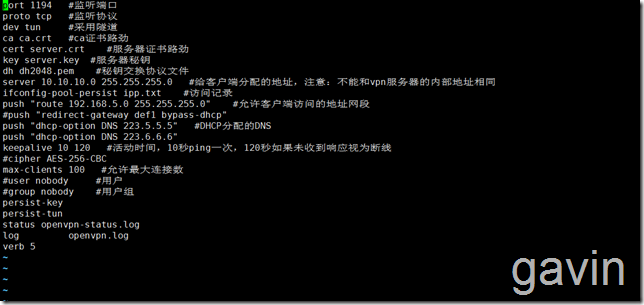
我们添加后
port 1194 #监听端口 proto tcp #监听协议 dev tun #采用隧道 ca ca.crt #ca证书路劲 cert server.crt #服务器证书路劲 key server.key #服务器秘钥 dh dh2048.pem #秘钥交换协议文件 server 10.10.10.0 255.255.255.0 #给客户端分配的地址,注意:不能和***服务器的内部地址相同 ifconfig-pool-persist ipp.txt #访问记录 push "route 192.168.5.0 255.255.255.0" #允许客户端访问的地址网段 #push "redirect-gateway def1 bypass-dhcp" push "dhcp-option DNS 223.5.5.5" #DHCP分配的DNS push "dhcp-option DNS 223.6.6.6" keepalive 10 120 #活动时间,10秒ping一次,120秒如果未收到响应视为断线 #cipher AES-256-CBC max-clients 100 #允许最大连接数 #user nobody #用户 #group nobody #用户组 persist-key persist-tun status open***-status.log log open***.log verb 5 client-cert-not-required username-as-common-name script-security 3 auth-user-pass-verify /etc/open***/checkpsw.sh via-env
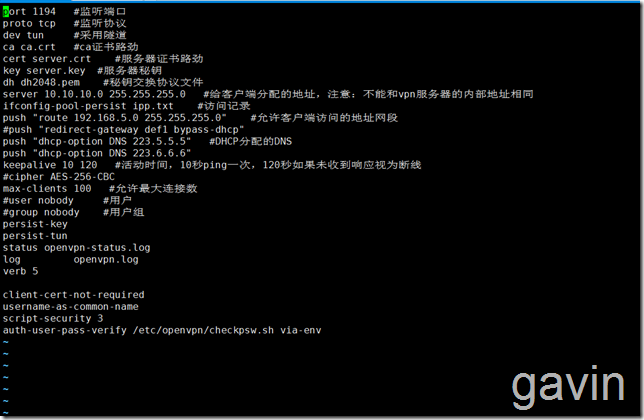
第三步:新建用户和密码认证文件,psw-file(这里的文件就是server.conf那个文件,注意存放时,路径和配置文件时的一致)
cd /etc/open***/ vim psw-file test123456 (前面是用户 后面是密码)

注:这里 psw-file的权限,尽量小点
chmod 400 psw-file chmod +x checkpsw.sh

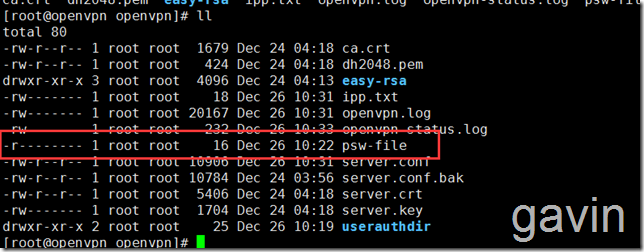
修改好后,我们重启open***服务

第四步:修改客户端配置文件:client.conf(或者client.o***)
注销掉这两行
#cert client1.crt #key client1.key
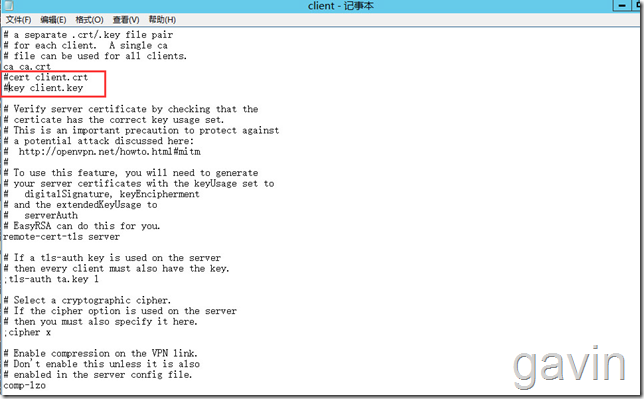
再添加这一行,添加这行,就会提示输入用户名和密码
auth-user-pass
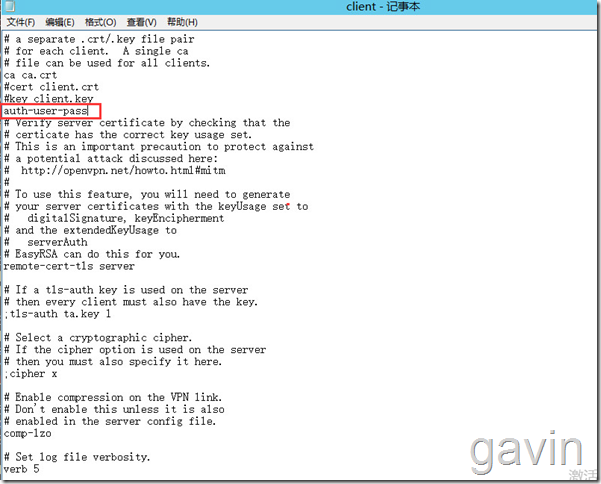
我们为了显示好看及好判断问题,所以我们需要把客户端的配置文件清空,然后编写有用的
client dev tun proto tcp remote 192.168.5.20 1194 resolv-retry infinite nobind persist-key persist-tun ca ca.crt # cert client.crt #key client.key #remote-cert-tls server verb 5 auth-user-pass
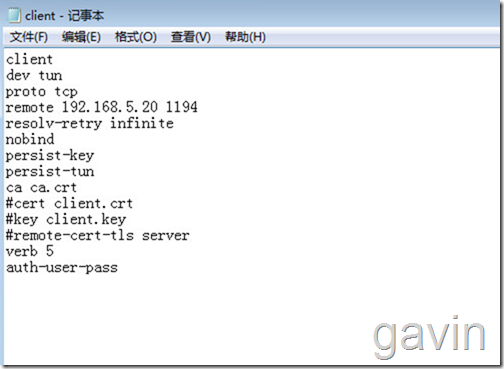
保存会,我们单击open***客户端,然后连接,会提示输入账户及密码
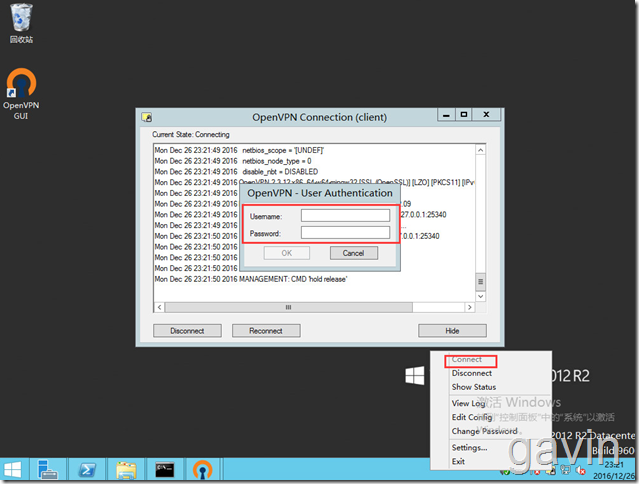
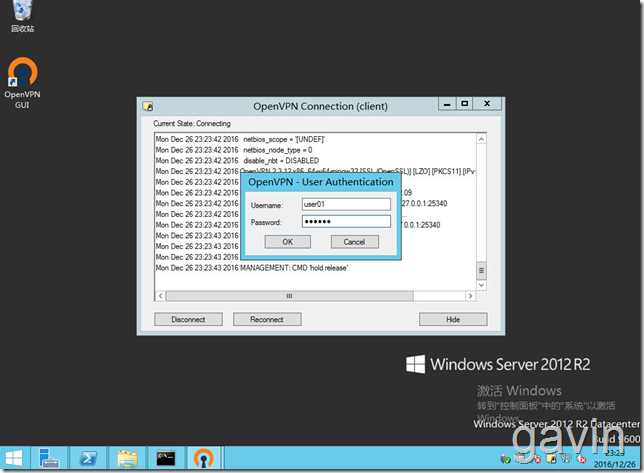
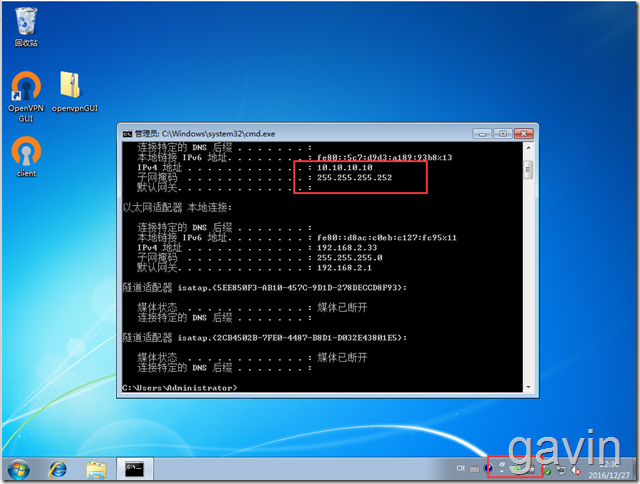
最后我们可以查看log确认登陆情况
tail -f /etc/open***/open***.log

tail -f /etc/open***/open***-password.log

转载于:https://blog.51cto.com/gaowenlong/1886732
Centos7+Open***使用用户及密码验证登陆相关推荐
- Elasticsearch、Elasticsearch-head、Kibana 安全设置账号密码验证登陆
Elasticsearch.Elasticsearch-head.Kibana 安全设置账号密码验证登陆 我的小站.Github.CSDN X-Pack 是 Elastic Stack 的一个扩展,提 ...
- centos7 创建新用户,使用ssh登陆,禁止root登陆,密码登陆
1.先使用root用户登陆,创建新用,为新用户创建密码 useradd guest passwd guest 2.为用户分配sudo权限 gpasswd -a guest wheel //给予sudo ...
- Java连接数据库实现用户登录密码验证
目录结构图: 1.在store_db数据库中创建一个t_user表; 在domain包中创建一个User的类: package com.xxf.domain;public class User {pr ...
- 随机验证码、用户登录密码验证、手机号加密案例
String类案例 1.随机数案例 package zrzy.qrs.stringequals;import java.util.Random;/** *需求:获取一个随机5位的验证码,包含字母大小写 ...
- Linux学习笔记35——特定权限设置(比group、user更细的设置)、身份切换(su、sudo)、密码验证过程详解(PAM)、批量创建用户
一.主机的细部权限规划:ACL 的使用 从第五章开始,我们就一直强调 Linux 的权限概念是非常重要的! 但是传统的权限仅有三种身份 ( owner, group, others) 搭配三种权限 ( ...
- Centos7.x 单用户模式修改root密码
介绍: 之前使用的Centos6的单用户模式发现不适合Centos7使用,于是使用VMware Workstation记录Centos7的操作. 1.重启需要重置密码的虚机 2.看到此界面后,快速按& ...
- CentOS7之新建用户与SSH登陆
登录云服务器 //选择一: 账号密码登录 ssh -q root@公用IP地址 然后输入密码(提示linux密码,没有长度****提示)//选择二:秘钥登录 ssh -i 公用秘钥文件路径 root@ ...
- 用户姓名保护python_Python操作LDAP,对用户进行认证(验证用户名以及密码)
Python操作LDAP,对用户进行认证 1.环境 Python版本: 3.7.1 操作系统:windows 7 x64 第三方包:python-ldap 2.LDAP LDAP,它是基于X.500标 ...
- emqx配置mysql认证,emqx使用mysql完成用户密码验证和ACL鉴权
emqx使用mysql完成用户密码验证和ACL鉴权 emqx使用mysql完成用户密码验证和ACL鉴权 摘要:前几篇博客介绍的是使用配置文件配置了ACL和客户端用户名密码配置实现生产环境下的安全登录和 ...
最新文章
- 一种准标准CSV格式的介绍和分析以及解析算法
- ELK(+Redis)+LogAnalyzer解决企业日志问题
- C# 获取当前路径方法
- Android 实用工具Hierarchy Viewer实战
- c java http_[C] 类似于HttpClient的C语言实现Http POST功能如何实现?
- tomcat拒绝访问是为什么_Tomcat中的connectTimeout和慢攻击
- 在sql server里,日期字段按天数进行group by查询的方法
- 微服务太分散?使用Fundebug集中式bug监控
- 【堪萨斯州立大学】电子和计算机工程系智能能源研究室、硬件安全实验室招募博士,提供多个全额奖学金机会...
- CCS实例,网页栏目
- 李峋同款的C语言动态爱心代码(终于不是html的啦)
- matlab求两向量夹角_高考数学一轮复习,利用空间向量求夹角和距离,各考点聚焦突破...
- 正样本/反(负)样本/易区分样本/难区分样本
- 物联网--ESP32开发笔记(2) domoticz mqtt的一些坑的记录
- 收集的JS常用正则表达式等(转载)
- 盛天海科技:拼多多团长这样来做
- 数学中说的线性关系线性是什么意思?
- 案例分享-21款奔驰S450L升级原厂夜色饰条套件
- 进入知识储备期的通知
- 知否:高增长时代已过,汽车互联网玩家如何开拓更多增量?
